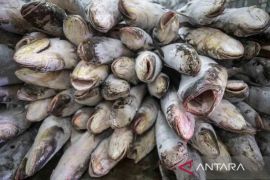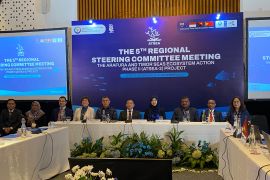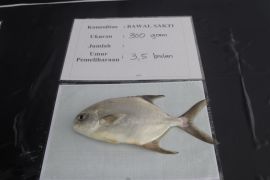"The target national shrimp export market includes the United States, Japan, China, ASEAN (nine countries), the European Union (27 countries), and has a positive growth of 12.97 percent year over year (yoy)," Marketing Director at the ministry’s Directorate General of Marine and Fisheries Product Competitiveness Improvement Erwin Dwiyana said.
He delivered the statement at a seminar and business meeting at the 9th National Fish Day series in Parigi Moutong on Saturday.
The seminar discussed the industrialization of vaname shrimp cultivation in the Tomini Bay area for supporting national food security.
Dwiyana said that Indonesia's shrimp exports to the US accounted for 71.6 percent of the total national shrimp exports, making the US the largest export destination for shrimp commodities. Japan was the next largest export destination with the volume of shrimp exports reaching 28 thousand tons, worth US$298 million.
The American market favors processed products, such as frozen peeled tropical shrimp, whose value reached US$2.2 billion in the period from January to August this year, as well as ready-to-cook processed shrimp products.
"There are also other processed shrimp products, such as flour-coated prawns, frozen whole prawns of various sizes as a product of cultivation," he informed.
Dwiyana said that the changes in the global economy also affected the exports of some national fishery commodities; however, other fishery products, including shrimp, actually saw some development.
According to statistical data, the average value of the global shrimp trade reached US$4.34 billion in the period from 2017 to 2021, with Indonesia cornering around 7.7 percent, or US$1.89 billion, of the commodity’s market share.
"In order to meet export needs, of course, (it can be done by ensuring) efficiency and increase in production with a cultivation system and pond revitalization as well as product certification," he said.
For maintaining and improving export supplies, his administration is trying to expedite access to international markets, promote and brand products, and improve logistics, he added.
This would also require the development of fish processing industrial areas that are integrated with areas for increasing shrimp production and logistics service providers.
"A number of national export commodities in the fisheries sector are crabs, seaweed, cuttlefish, octopus, tunas, shrimp, and mixed fish," Dwiyana said.
Related news: Ministry seeks improvement in fishery product branding at global level
Related news: Ministry-US FDA collaboration aims to ensure shrimp export quality
Translator: Mohamad Ridwan, Mecca Yumna
Editor: Rahmad Nasution
Copyright © ANTARA 2022












